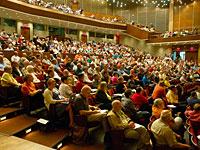How do we reunite what (arguably) should never have been divided? From our 21st- century perspective the Christian Reformed Church (CRC) was woefully misbegotten.
In 1857 four congregations of recent immigrants from the Netherlands left what is now called the Reformed Church in America (RCA) to strike out on their own. Their reasons for walking now seem foreign:
- The RCA was too American for the CRC folks, who wanted to speak and stay Dutch.
- The RCA did not sufficiently support the CRC folks’ cause against the church they had split from in the Netherlands.
- The RCA allowed visitors to the Lord’s Table (communion) instead of restricting participation to members only.
- The RCA didn’t restrict songs sung in worship services to the Psalms, but also sang hymns.
Today those reasons seem wrongheaded. Our split wasn’t about truth and heresy, about rejection of Scripture, creeds, or Reformed confessions. It was about culture and questionable church practices.
Splitting a church is like shattering a bone. The break happens all too quickly and easily. But the healing process, if even possible, takes a long, long time and lots of strenuous, painful effort.
By God’s grace that work has already begun. In fact, this year the CRC and the RCA held their first-ever joint synod (denominationwide leadership meeting) between the wrap-up of the CRC’s synod and the start of the RCA’s.
In that joint meeting the combined synods did two things: (1) They adopted jointly produced translations of our shared confessions, which will make it easier for us to share liturgical resources and study materials. (2) They also celebrated the work we’re already doing together. To name a few items from a much longer list:
- Sharing of pastors
- Joint congregations and new church starts
- Joint resource distribution and publication
- Leadership resourcing and education
- Collaborative disabilities ministries
- Mission, relief, and development work
There’s more to come. The more we work together, the more we trust and like each other. So we find even more areas to work together.
The rumor mill is beginning to grind—will our successful dating lead to marriage? Who knows? There are serious obstacles we’d need to overcome: opposite approaches to Christian education, structural differences on how local churches relate to the denomination, different polarities and cultures, among others.
So eloping seems out of the question. We’ll need to take it slow: a joint synod meeting here, a joint worship service there. . . . And in the meantime, let’s do even more stuff together, like
Have our colleges and seminaries synchronize their offerings to allow for greater specialization and mutual coordination of programs, courses, etc.
Integrate more denominational services—why duplicate?
Plan joint classis meetings; maybe even integrate classes (regional groups of churches) and their work somehow.
Let’s take our time but also further steps. Jesus pleaded, “I pray that all of them will be one, [Father,] just as you are in me and I am in you” (John 17:21).
The more we get together, the happier He’ll be.
About the Author
Bob De Moor is a retired Christian Reformed pastor living in Edmonton, Alta.





